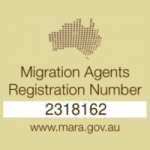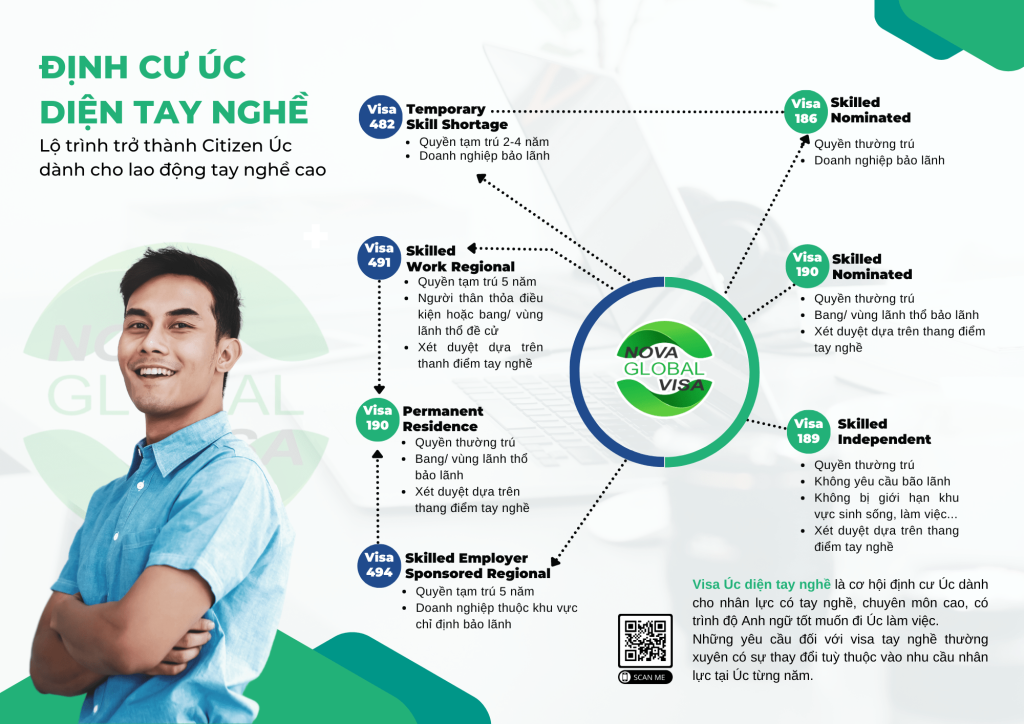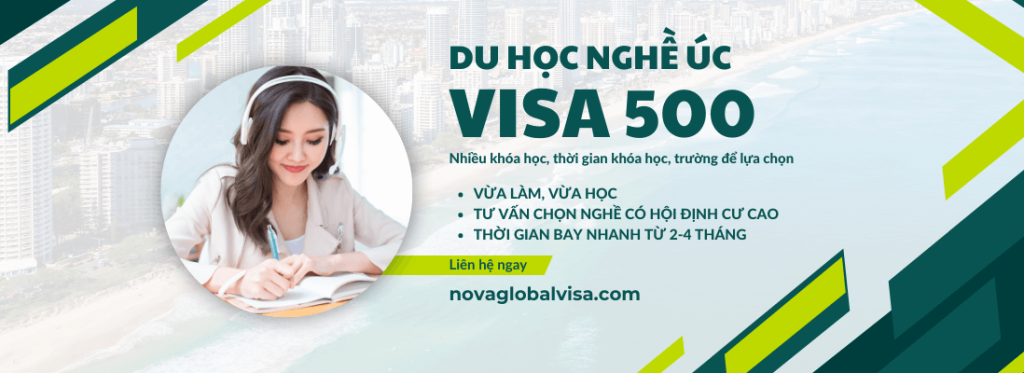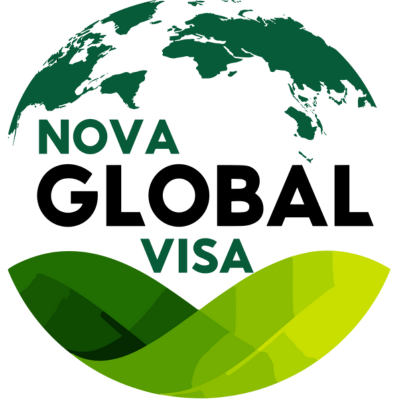
WORKING AND SKILLED VISAS
Registered migration agents – MARN 2318162

Skilled Australian immigration pathways
Australia has many types of skilled visas, and each year Australia may open or close more or less priority categories or occupations depending on Australia’s labor needs. In 2022, Australia has about 11 types of skilled visas. In this article, Nova will only introduce 7 visas that can lead to permanent residency, divided into 3 groups:
- Sponsored by a company: The visa applicant is sponsored by an Australian employer to work in Australia.
- Nominated by a state/territory or a qualifying relative: The visa applicant is nominated by a state or territory government or a qualifying relative to live and work in Australia.
- Independent skilled: The visa applicant meets the requirements for a skilled visa without being sponsored or nominated by another party.
From these 7 skilled visas, there will be 6 immigration routes (as illustrated). Details of each type of visa are presented below by Nova Global Visa.

List of Australian Skilled Visas
Australian Skilled Visa is an opportunity to settle in Australia for skilled, highly specialized and good English-speaking people who want to work in Australia. The requirements for skilled visas often change depending on the demand for manpower in Australia from year to year.
Australian Skilled Visa list:
- Temporary Skill Shortage visa (subclass 482)
- Employer Nomination Scheme visa (Subclass 186)
- Skilled Work Regional (Provisional) visa (Subclass 491)
- Skilled Employer Sponsored Regional (Provisional) visa (Subclass 494)
- Skilled Nominated visa (Subclass 190)
- Permanent Residence (Skilled Regional) visa(Subclass 191)
- Skilled independent visa (Subclass 189)
Skilled Migration Occupation Lists
Australia’s skills-related migration visas are underpinned by the following lists, which combine to form the Skilled Migration Occupation List:
- Short-Term Skilled Occupation List
- Medium and Long-Term Strategic Skills List
- Regional Occupation List.
The current Skilled Migration Occupation Lists can be found on the Department of Home Affairs website.
The Medium and Long-term Strategic Skills List (MLTSSL) is a list of occupations that are in demand in Australia for the medium to long term. The MLTSSL is used by the Australian government to determine which skilled workers are eligible for visas under the Skilled Independent visa (subclass 189) and the Skilled Nominated visa (subclass 190).
The MLTSSL is updated every six months to reflect the changing labor market needs of Australia. The occupations on the MLTSSL are divided into two categories:
- Priority occupations: These occupations are in high demand in Australia and have a shortage of skilled workers.
- In demand occupations: These occupations are also in demand in Australia, but there is not as much of a shortage of skilled workers.
To be eligible for a visa under the MLTSSL, an applicant must meet the skills and experience requirements for the nominated occupation and pass a health and character test. They must also score at least 65 points on the SkillSelect points test.
The MLTSSL is a great resource for skilled workers who are interested in permanent residency in Australia. The MLTSSL can help you find a job in a high-demand occupation and get a visa to live and work in Australia permanently. Here are some additional details about the MLTSSL:
- The MLTSSL is published by the Department of Home Affairs.
- The MLTSSL is available online.
- The MLTSSL is updated every six months.
- The MLTSSL is divided into two categories: priority occupations and in demand occupations.
- Applicants for visas under the MLTSSL must meet the skills and experience requirements for the nominated occupation and pass a health and character test.
- Applicants must also score at least 65 points on the SkillSelect points test.
If you are a skilled worker who is interested in permanent residency in Australia, I recommend checking the MLTSSL to see if your occupation is in demand. The MLTSSL can help you find a job and get a visa to live and work in Australia permanently.
The Short-term Skilled Occupation List (STSOL) is a list of occupations that are in demand in Australia for a limited period of time. The STSOL is used by the Australian government to determine which skilled workers are eligible for visas under the Short-term Skilled visa (subclass 482) and the Employer Nomination Scheme (subclass 186).
The STSOL is updated every six months to reflect the changing labor market needs of Australia. The occupations on the STSOL are divided into two categories:
- In demand occupations: These occupations are in high demand in Australia and have a shortage of skilled workers.
- Eligible occupations: These occupations are not in high demand in Australia, but they are still eligible for visas under the STSOL.
To be eligible for a visa under the STSOL, an applicant must have a valid job offer in Australia and their occupation must be on the STSOL. The applicant must also meet the skills and experience requirements for the nominated occupation and pass a health and character test.
The STSOL is a great resource for skilled workers who are interested in working in Australia for a limited period of time. The STSOL can help you find a job in a high-demand occupation and get a visa to live and work in Australia.
Here are some additional details about the STSOL:
- The STSOL is published by the Department of Home Affairs.
- The STSOL is available online.
- The STSOL is updated every six months.
- The STSOL is divided into two categories: in demand occupations and eligible occupations.
- Applicants for visas under the STSOL must have a valid job offer in Australia and their occupation must be on the STSOL.
- Applicants must also meet the skills and experience requirements for the nominated occupation and pass a health and character test.
If you are a skilled worker who is interested in working in Australia for a limited period of time, I recommend checking the STSOL to see if your occupation is in demand. The STSOL can help you find a job and get a visa to live and work in Australia.
The Regional Occupation List (ROL) is a list of occupations that are in demand in regional Australia. The ROL is used by the Australian government to determine which skilled workers are eligible for visas under the Regional Sponsored Migration Scheme (RSMS).
The ROL is updated every six months to reflect the changing labor market needs of regional Australia. The occupations on the ROL are divided into three categories:
- Priority occupations: These occupations are in high demand in regional Australia and have a shortage of skilled workers.
- In demand occupations: These occupations are also in demand in regional Australia, but there is not as much of a shortage of skilled workers.
- Eligible occupations: These occupations are not in high demand in regional Australia, but they are still eligible for visas under the RSMS.
To be eligible for a visa under the RSMS, an applicant must have a valid job offer in a regional area of Australia and their occupation must be on the ROL. The applicant must also meet the skills and experience requirements for the nominated occupation and pass a health and character test.
The ROL is a great resource for skilled workers who are interested in moving to regional Australia. The ROL can help you find a job in a high-demand occupation and get a visa to live and work in regional Australia.
Here are some additional details about the ROL:
- The ROL is published by the Department of Home Affairs.
- The ROL is available online.
- The ROL is updated every six months.
- The ROL is divided into three categories: priority occupations, in demand occupations, and eligible occupations.
- Applicants for visas under the RSMS must have a valid job offer in a regional area of Australia and their occupation must be on the ROL.
- Applicants must also meet the skills and experience requirements for the nominated occupation and pass a health and character test.
If you are a skilled worker who is interested in moving to regional Australia, I recommend checking the ROL to see if your occupation is in demand. The ROL can help you find a job and get a visa to live and work in regional Australia.
The Regional Sponsored Migration Scheme (RSMS) is an Australian immigration program that allows skilled workers to move to regional Australia with the support of a state or territory government. The RSMS is designed to address labor shortages in regional Australia and to attract skilled workers to these areas.
To be eligible for the RSMS, applicants must meet certain requirements, including:
- Having a valid job offer in a regional area of Australia
- Meeting the skills and experience requirements for the nominated occupation
- Passing a health and character test
- Having enough money to support themselves and their family in Australia
If an applicant meets all of the requirements, they can be nominated by a state or territory government for the RSMS. Once they are nominated, they can apply for a visa to live and work in regional Australia.
The RSMS offers a number of benefits to skilled workers, including:
- The ability to live and work in regional Australia
- The opportunity to apply for permanent residency after 2 years of living in regional Australia
- Access to government support programs for skilled migrants
If you are a skilled worker who is interested in moving to regional Australia, the RSMS is a great option. The RSMS can help you find a job, get a visa, and settle into your new life in Australia.
Here are some additional details about the RSMS:
- The RSMS is open to skilled workers from a variety of occupations, including:
- Healthcare professionals
- Education professionals
- Engineering professionals
- Information technology professionals
- Tradespeople
- And many more!
- The RSMS is open to workers from all countries, but there may be some restrictions on the number of visas that are available from certain countries.
- The RSMS is a popular program, and there is often a waiting list for visas.
- If you are interested in applying for the RSMS, you should contact the state or territory government in the region where you want to live. They will be able to provide you with more information about the program and how to apply.

Australian Skills Assessment
To be eligible for a skilled visa application (skill subclass 491, 494, 186, 190 or 482 (some occupations)), applicants need to pass a skills assessment called a Skill Assessment (SA). ) by an Australian competent authority. So how to get SA? Which SA review agency is suitable for which profession? Find out with Nova in the following article about Skill Assessment (SA) .
Personal income tax and medicare
Personal income tax rates show the amount of tax payable per AUD earned under the income tax bracket depending on your state of residence. Learn how personal income tax and Medicare tax are calculated .



 Nova Global Visa © Copyright 2022
Nova Global Visa © Copyright 2022